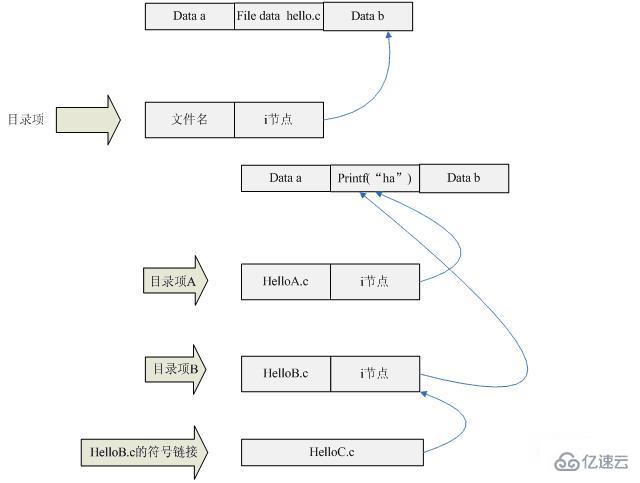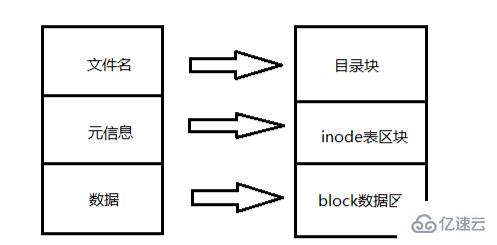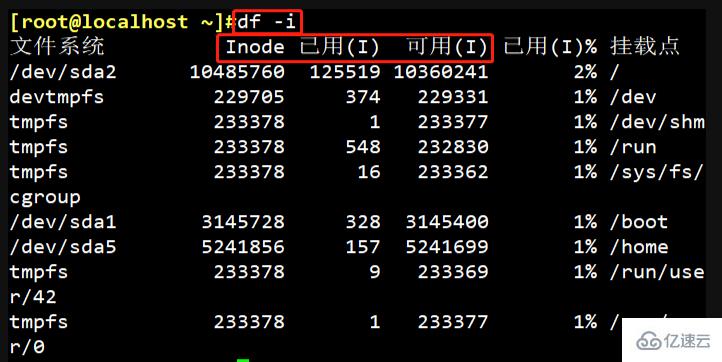 Operation and Maintenance
Operation and Maintenance
 Linux Operation and Maintenance
Linux Operation and Maintenance
 What does the linux i-node number mean?
What does the linux i-node number mean?
What does the linux i-node number mean?
The inode number is the number identifier used to distinguish different files in the Linux system. Linux internally uses inode numbers to identify files, rather than file names. For the system, file names are another name for inode numbers, which is convenient for users to identify files. There is a one-to-one correspondence between file names and inode numbers, and each inode number corresponds to A filename.
1. The i node in Linux
In Linux, the i node refers to the inode node.
In Linux, file search is not done by file name. In fact, the search and positioning of files is achieved through i nodes. We can visualize the i node as a pointer fip. When a file is stored on the disk, the file will definitely be stored in a disk location. You can imagine that since the file data is stored on the disk, if we know the address of the file data, when we want to read and write the file At this time, can we just use this address to find the file?
Yes, under Linux, the i-node can actually be thought of like this. The i-node is regarded as an address pointing to the file storage area on the disk. Normally, we cannot use this address directly, but need to use it indirectly through the file name. In fact, in addition to the address of the file data storage area, the i node also contains a large amount of other information, such as file size, file information, etc. But the i node does not save the file name. The file name is saved in a directory entry. Each directory entry contains the file name and i-node.
We can use a diagram to see the relationship between directory entries, i nodes, and file data.

As you can see from the above figure, the directory entry contains the file name and i node.
At the same time, you will find that in the above figure, the i nodes of directory item A and directory item B point to the same storage area, and this storage area stores the data of printf ("ha").
That means the contents of helloA.c and helloB.c are the same.
iNode number
Each inode has a number (i.e. inode number), and the operating system uses the inode number to identify different files.
————Linux internally uses inode numbers to identify files, not file names. For the system, file names are another name for inode numbers, which is convenient for users to identify files. File names and inode numbers are the same. A corresponding relationship, each inode number corresponds to a file name.
The inode number is the only code recognized by the system, and the file name is only for user identification. The inode (index node) table contains a list of all files in the file system. One node (index node) is in a table entry. , contains information (metadata) about the file.
Structure after hard disk partition:

When a user tries to access a file in a Linux system, the system will first name to find its corresponding inode number; obtain the inode information through the inode number; check whether the user has the permission to access the file according to the inode information; if so, point to the corresponding data block and read the data; if not will return.
Simple process for accessing files:

2. Linux file storage
2.1 Limit on the number of inodes
#Inodes also consume hard disk space, so when formatting, the operating system automatically divides the hard disk into two areas: one is the data area , stores file data; the other is the inode area, which stores the information contained in the inode. The size of each inode is generally 128 bytes or 256 bytes.
Normally, you don’t need to pay attention to the size of a single inode, but you need to focus on the total number of inodes. The total number of inodes has already been determined during formatting
——Why is the focus needed? Pay attention to the total number of inodes, because when the inodes are used up, new files cannot be created even if there is still space on the disk , because when creating a file, an inode number is required to correspond to it, and naturally it is impossible to create a new file without an inode. document.
Execute the "df-i" command to view the total number of inodes corresponding to each hard disk partition and the number of used inodes.

2.2 The content of inode
The inode contains the meta-information of the file, specifically the following contents:
The number of bytes of the file
The owner of the file user ID
The group of the file ID
File read, write, and execute permissions
Number of links, that is, how many files point to this inode
The timestamp of the file
Two ways to view the inode information of a certain file
Method 1: stat [file name]
Example: stat aa.txt

Advantages: You can view the detailed information of the file inode
Method 2: ls -i [file name]

Only the inode number can be displayed
2.3 Three main time attributes of Linux system files
The three main time attributes of Linux system files (that is, the timestamp in the inode)
ctime (change time)
refers to the last changeThe time of the file or directory (attribute)atime (access time)
refers to the last access to the file or Directory timemtime (modify time)
refers to the time when the last modification file or directory (content)
3. The special function of inode
Because the inode number is separated from the file name, some Unix/Linux systems have the following phenomena :
When the file name contains special characters, the file may not be deleted normally. Delete the inode directly, or you can delete the file
Move Or when renaming a file, only the file name is changed and the inode number is not affected
After opening a file, the system identifies the file by the inode number and no longer considers the file name
After the file data is modified and saved, a new inode number will be generated (the original inode number will be released)
How to delete the inode Delete file number:
Method 1 (information required before deletion): find ./ -inum [inode number] -exec rm -i {} \ ;

Method 2 (direct deletion): find ./ -inum [inode number] -delete

The above is the detailed content of What does the linux i-node number mean?. For more information, please follow other related articles on the PHP Chinese website!

Hot AI Tools

Undresser.AI Undress
AI-powered app for creating realistic nude photos

AI Clothes Remover
Online AI tool for removing clothes from photos.

Undress AI Tool
Undress images for free

Clothoff.io
AI clothes remover

AI Hentai Generator
Generate AI Hentai for free.

Hot Article

Hot Tools

Notepad++7.3.1
Easy-to-use and free code editor

SublimeText3 Chinese version
Chinese version, very easy to use

Zend Studio 13.0.1
Powerful PHP integrated development environment

Dreamweaver CS6
Visual web development tools

SublimeText3 Mac version
God-level code editing software (SublimeText3)

Hot Topics
 1385
1385
 52
52
 Difference between centos and ubuntu
Apr 14, 2025 pm 09:09 PM
Difference between centos and ubuntu
Apr 14, 2025 pm 09:09 PM
The key differences between CentOS and Ubuntu are: origin (CentOS originates from Red Hat, for enterprises; Ubuntu originates from Debian, for individuals), package management (CentOS uses yum, focusing on stability; Ubuntu uses apt, for high update frequency), support cycle (CentOS provides 10 years of support, Ubuntu provides 5 years of LTS support), community support (CentOS focuses on stability, Ubuntu provides a wide range of tutorials and documents), uses (CentOS is biased towards servers, Ubuntu is suitable for servers and desktops), other differences include installation simplicity (CentOS is thin)
 How to use docker desktop
Apr 15, 2025 am 11:45 AM
How to use docker desktop
Apr 15, 2025 am 11:45 AM
How to use Docker Desktop? Docker Desktop is a tool for running Docker containers on local machines. The steps to use include: 1. Install Docker Desktop; 2. Start Docker Desktop; 3. Create Docker image (using Dockerfile); 4. Build Docker image (using docker build); 5. Run Docker container (using docker run).
 Centos options after stopping maintenance
Apr 14, 2025 pm 08:51 PM
Centos options after stopping maintenance
Apr 14, 2025 pm 08:51 PM
CentOS has been discontinued, alternatives include: 1. Rocky Linux (best compatibility); 2. AlmaLinux (compatible with CentOS); 3. Ubuntu Server (configuration required); 4. Red Hat Enterprise Linux (commercial version, paid license); 5. Oracle Linux (compatible with CentOS and RHEL). When migrating, considerations are: compatibility, availability, support, cost, and community support.
 How to install centos
Apr 14, 2025 pm 09:03 PM
How to install centos
Apr 14, 2025 pm 09:03 PM
CentOS installation steps: Download the ISO image and burn bootable media; boot and select the installation source; select the language and keyboard layout; configure the network; partition the hard disk; set the system clock; create the root user; select the software package; start the installation; restart and boot from the hard disk after the installation is completed.
 Detailed explanation of docker principle
Apr 14, 2025 pm 11:57 PM
Detailed explanation of docker principle
Apr 14, 2025 pm 11:57 PM
Docker uses Linux kernel features to provide an efficient and isolated application running environment. Its working principle is as follows: 1. The mirror is used as a read-only template, which contains everything you need to run the application; 2. The Union File System (UnionFS) stacks multiple file systems, only storing the differences, saving space and speeding up; 3. The daemon manages the mirrors and containers, and the client uses them for interaction; 4. Namespaces and cgroups implement container isolation and resource limitations; 5. Multiple network modes support container interconnection. Only by understanding these core concepts can you better utilize Docker.
 How to view the docker process
Apr 15, 2025 am 11:48 AM
How to view the docker process
Apr 15, 2025 am 11:48 AM
Docker process viewing method: 1. Docker CLI command: docker ps; 2. Systemd CLI command: systemctl status docker; 3. Docker Compose CLI command: docker-compose ps; 4. Process Explorer (Windows); 5. /proc directory (Linux).
 What computer configuration is required for vscode
Apr 15, 2025 pm 09:48 PM
What computer configuration is required for vscode
Apr 15, 2025 pm 09:48 PM
VS Code system requirements: Operating system: Windows 10 and above, macOS 10.12 and above, Linux distribution processor: minimum 1.6 GHz, recommended 2.0 GHz and above memory: minimum 512 MB, recommended 4 GB and above storage space: minimum 250 MB, recommended 1 GB and above other requirements: stable network connection, Xorg/Wayland (Linux)
 What to do if the docker image fails
Apr 15, 2025 am 11:21 AM
What to do if the docker image fails
Apr 15, 2025 am 11:21 AM
Troubleshooting steps for failed Docker image build: Check Dockerfile syntax and dependency version. Check if the build context contains the required source code and dependencies. View the build log for error details. Use the --target option to build a hierarchical phase to identify failure points. Make sure to use the latest version of Docker engine. Build the image with --t [image-name]:debug mode to debug the problem. Check disk space and make sure it is sufficient. Disable SELinux to prevent interference with the build process. Ask community platforms for help, provide Dockerfiles and build log descriptions for more specific suggestions.



